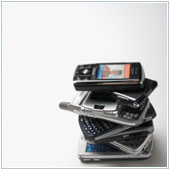| Next big thing: Non dedicated devices? |
Traditional smartphones are individual packages. The operating system and user are physically tied to the device. If you think about it, there are really only a few phones out there, and millions of people probably have the exact same one that you do. They differentiate their phones from others by the pictures, apps, videos, etc. stored on the device and the way they have personalized their phones. Should you lose your phone, that data is likely lost, and you are faced with a potentially high cost to replace it. The two major operating system developers – Apple (iOS) and Google (Android) – have started to implement virtual backup solutions. Your contacts, apps and some personalization settings are backed up to the cloud and connected with a user account. When you enter the account information, you can quickly get the most important information from your phone back. Combine this with the various cloud storage services that allow users to store their information, pictures, etc., with access from nearly any device. This integration with the cloud has enabled users to rely less on physical devices, and points to a potential virtualization concept: Non-dedicated devices. The idea of non-dedicated devices is that you can use any device, regardless of manufacturer or OS, to access a system you can call your own. Imagine if your phone runs out of batteries. You borrow a friend’s, log in using your username and password and that device instantly becomes personalized to you. Could this work?
It wouldn’t be hard for an enterprising company to develop a system that integrates these three, already existing functions into a device. The only major stumbling block we can see is that current OS developers don’t necessarily get along all that well. We predict that this virtualization will become a possibility on individual systems (Android and iOS), in the near future, but across systems may take longer. We’d like to know what you think of non-dedicated devices. Would you use one? Are there any other problems you can foresee? Let us know today. Published with permission from TechAdvisory.org. Source.
|
| Is your BCP resilient? |
|
| 6 ways to reduce printer costs |
|
| Prey tracks your important devices |
|
| Copy and paste in Word with ease |
|


 The mobile phone has become an integral part of any business owners tech toolbox. Unlike other systems however, it has remained a largely physical device. Desktops and servers on the other hand have seen virtualization take hold, and businesses benefit from this. Is there a chance that your smartphone could see virtualization applied to its systems? It very well might do.
The mobile phone has become an integral part of any business owners tech toolbox. Unlike other systems however, it has remained a largely physical device. Desktops and servers on the other hand have seen virtualization take hold, and businesses benefit from this. Is there a chance that your smartphone could see virtualization applied to its systems? It very well might do. One of the major objectives of almost every business is to remain operational. From time-to-time there might be factors, such as a natural disaster, that could put your company at risk. To mitigate this threat, companies have started to adopt a Business Continuity Plan with the aim of being able to recover from such disastrous events.
One of the major objectives of almost every business is to remain operational. From time-to-time there might be factors, such as a natural disaster, that could put your company at risk. To mitigate this threat, companies have started to adopt a Business Continuity Plan with the aim of being able to recover from such disastrous events. Small to medium businesses are highly susceptible to increasing operational costs. An increase of only USD$1.00 for an essential item could be enough to force a company out of business. That’s why many business owners are always on the search for ways to cut costs. One way which is often overlooked is reducing the costs associated with your printers.
Small to medium businesses are highly susceptible to increasing operational costs. An increase of only USD$1.00 for an essential item could be enough to force a company out of business. That’s why many business owners are always on the search for ways to cut costs. One way which is often overlooked is reducing the costs associated with your printers. The number of tech gadgets we own has been growing, as has the number of criminals targeting high value goods like laptops and smartphones. While it is more likely to not happen, there is still a chance your laptop or phone could be stolen or go missing. When it does, you could lose important data, especially if you use this for your work too. To help increase the chances of finding your device you can install a program that tracks it.
The number of tech gadgets we own has been growing, as has the number of criminals targeting high value goods like laptops and smartphones. While it is more likely to not happen, there is still a chance your laptop or phone could be stolen or go missing. When it does, you could lose important data, especially if you use this for your work too. To help increase the chances of finding your device you can install a program that tracks it. Computers and the software we use have been instrumental in enabling businesses to reach previously unseen and unattainable levels of productivity. While many programs are a major part of any computer, only a handful have been integrated in nearly every business. One such program is Microsoft Office, and it’s word processor Word. There are many productivity enhancing features of Word, including copy and paste.
Computers and the software we use have been instrumental in enabling businesses to reach previously unseen and unattainable levels of productivity. While many programs are a major part of any computer, only a handful have been integrated in nearly every business. One such program is Microsoft Office, and it’s word processor Word. There are many productivity enhancing features of Word, including copy and paste.